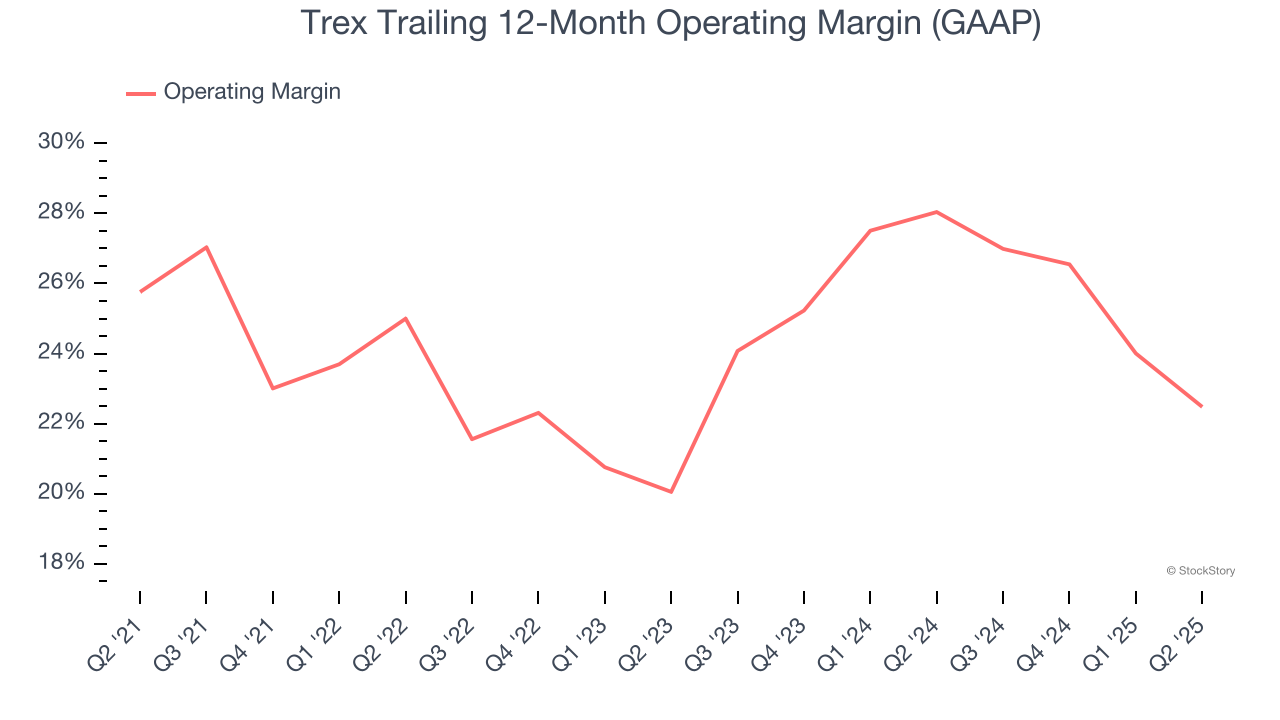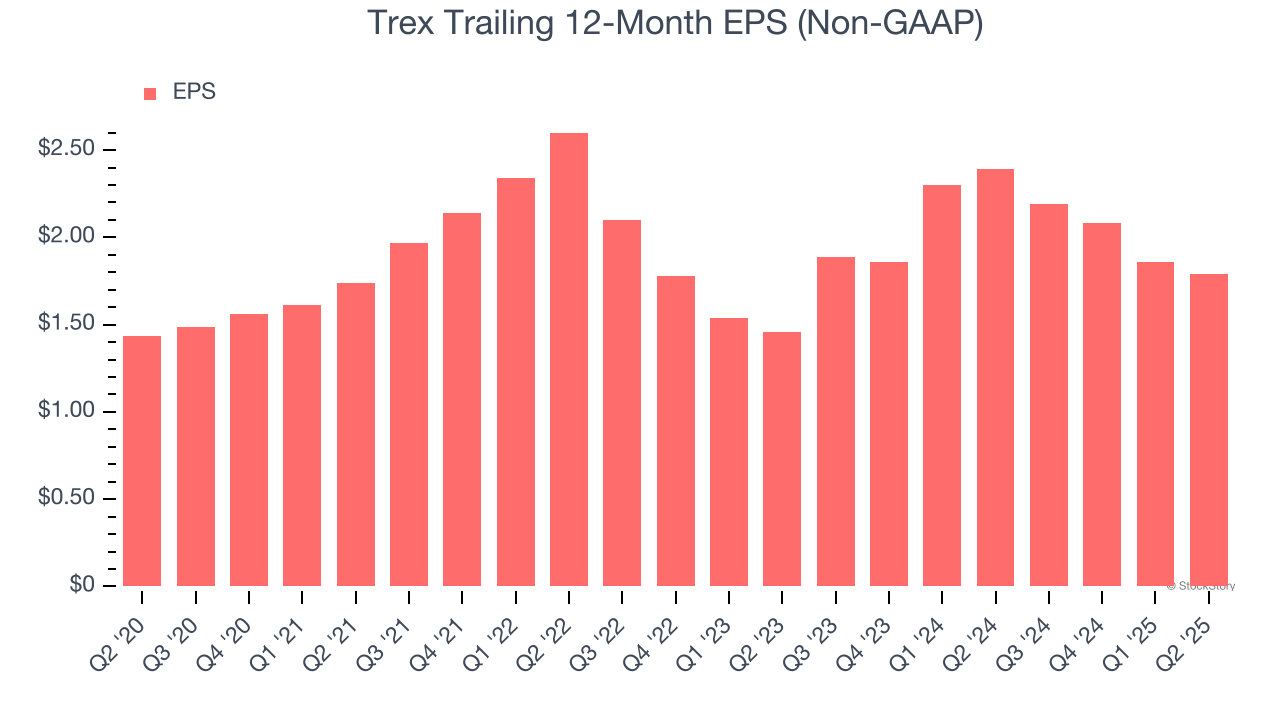
Composite decking and railing products manufacturer Trex Company (NYSE:TREX) beat Wall Street’s revenue expectations in Q2 CY2025, with sales up 3% year on year to $387.8 million. On the other hand, next quarter’s revenue guidance of $300 million was less impressive, coming in 1% below analysts’ estimates. Its non-GAAP profit of $0.73 per share was 2.8% above analysts’ consensus estimates.
Is now the time to buy Trex? Find out by accessing our full research report, it’s free.
Trex (TREX) Q2 CY2025 Highlights:
- Revenue: $387.8 million vs analyst estimates of $377.1 million (3% year-on-year growth, 2.8% beat)
- Adjusted EPS: $0.73 vs analyst estimates of $0.71 (2.8% beat)
- Adjusted EBITDA: $122 million vs analyst estimates of $117.9 million (31.5% margin, 3.5% beat)
- Revenue Guidance for Q3 CY2025 is $300 million at the midpoint, below analyst estimates of $303.1 million
- Operating Margin: 26.4%, down from 31.1% in the same quarter last year
- Free Cash Flow Margin: 52.3%, up from 42% in the same quarter last year
- Market Capitalization: $6.8 billion
“Our prominent position in both the pro channel and home centers enabled Trex to deliver another quarter of sales performance that exceeded expectations,” said Bryan Fairbanks, President and CEO.
Company Overview
Addressing the demand for aesthetically-pleasing and unique outdoor living spaces, Trex Company (NYSE:TREX) makes wood-alternative decking, railing, and patio furniture.
Revenue Growth
Examining a company’s long-term performance can provide clues about its quality. Any business can put up a good quarter or two, but the best consistently grow over the long haul. Thankfully, Trex’s 7.7% annualized revenue growth over the last five years was decent. Its growth was slightly above the average industrials company and shows its offerings resonate with customers.

Long-term growth is the most important, but within industrials, a half-decade historical view may miss new industry trends or demand cycles. Trex’s annualized revenue growth of 7.6% over the last two years aligns with its five-year trend, suggesting its demand was stable. 
This quarter, Trex reported modest year-on-year revenue growth of 3% but beat Wall Street’s estimates by 2.8%. Company management is currently guiding for a 28.4% year-on-year increase in sales next quarter.
Looking further ahead, sell-side analysts expect revenue to grow 13% over the next 12 months, an improvement versus the last two years. This projection is noteworthy and suggests its newer products and services will catalyze better top-line performance.
Today’s young investors won’t have read the timeless lessons in Gorilla Game: Picking Winners In High Technology because it was written more than 20 years ago when Microsoft and Apple were first establishing their supremacy. But if we apply the same principles, then enterprise software stocks leveraging their own generative AI capabilities may well be the Gorillas of the future. So, in that spirit, we are excited to present our Special Free Report on a profitable, fast-growing enterprise software stock that is already riding the automation wave and looking to catch the generative AI next.
Operating Margin
Operating margin is one of the best measures of profitability because it tells us how much money a company takes home after procuring and manufacturing its products, marketing and selling those products, and most importantly, keeping them relevant through research and development.
Trex has been a well-oiled machine over the last five years. It demonstrated elite profitability for an industrials business, boasting an average operating margin of 24.5%. This result isn’t surprising as its high gross margin gives it a favorable starting point.
Looking at the trend in its profitability, Trex’s operating margin decreased by 3.3 percentage points over the last five years. This raises questions about the company’s expense base because its revenue growth should have given it leverage on its fixed costs, resulting in better economies of scale and profitability.

In Q2, Trex generated an operating margin profit margin of 26.4%, down 4.6 percentage points year on year. Since Trex’s operating margin decreased more than its gross margin, we can assume it was less efficient because expenses such as marketing, R&D, and administrative overhead increased.
Earnings Per Share
Revenue trends explain a company’s historical growth, but the long-term change in earnings per share (EPS) points to the profitability of that growth – for example, a company could inflate its sales through excessive spending on advertising and promotions.
Trex’s EPS grew at an unimpressive 4.5% compounded annual growth rate over the last five years, lower than its 7.7% annualized revenue growth. This tells us the company became less profitable on a per-share basis as it expanded due to non-fundamental factors such as interest expenses and taxes.

We can take a deeper look into Trex’s earnings to better understand the drivers of its performance. As we mentioned earlier, Trex’s operating margin declined by 3.3 percentage points over the last five years. This was the most relevant factor (aside from the revenue impact) behind its lower earnings; interest expenses and taxes can also affect EPS but don’t tell us as much about a company’s fundamentals.
Like with revenue, we analyze EPS over a shorter period to see if we are missing a change in the business.
For Trex, its two-year annual EPS growth of 10.7% was higher than its five-year trend. This acceleration made it one of the faster-growing industrials companies in recent history.
In Q2, Trex reported adjusted EPS at $0.73, down from $0.80 in the same quarter last year. Despite falling year on year, this print beat analysts’ estimates by 2.8%. Over the next 12 months, Wall Street expects Trex’s full-year EPS of $1.79 to grow 34.1%.
Key Takeaways from Trex’s Q2 Results
We enjoyed seeing Trex beat analysts’ revenue expectations this quarter. We were also happy its EBITDA outperformed Wall Street’s estimates. On the other hand, its revenue guidance for next quarter slightly missed. Overall, this print was mixed. The stock remained flat at $64.50 immediately following the results.
Trex may have had a good quarter, but does that mean you should invest right now? The latest quarter does matter, but not nearly as much as longer-term fundamentals and valuation, when deciding if the stock is a buy. We cover that in our actionable full research report which you can read here, it’s free.
